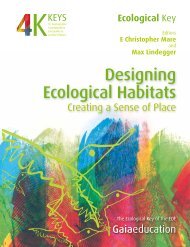EDE Curriculum 2012.pdf - Gaia Education
EDE Curriculum 2012.pdf - Gaia Education
EDE Curriculum 2012.pdf - Gaia Education
Create successful ePaper yourself
Turn your PDF publications into a flip-book with our unique Google optimized e-Paper software.
Module 1: Green Building and Retrofitting<br />
Learning Goals<br />
� Evaluating objectively the problems inherent in ‘modern’ building and construction techniques<br />
� Increasing familiarity with various ‘green,’ sometimes called ‘alternative,’ building techniques<br />
whose designs provide healthier, more energy efficient and less environmentally damaging<br />
structures<br />
� Gaining awareness of the need to discriminate as to the choice of building materials and architectural<br />
styles best suited to a specific bioregion<br />
� Explore issues in retrofitting poorly designed structures, including urban and suburban patterns<br />
� Develop plans for rehabilitating and re-inhabiting partially or completely abandoned existing<br />
settlements; reconstructing lost cultural identity<br />
Content<br />
This module looks at the healthy building issue in some detail and offers a variety of solutions to improve<br />
it. Materials will be investigated one by one and assessed from the aspects of manufacturer and<br />
user health, environmental impact, costs, and user comfort. The concept of “embodied energy” will be<br />
explored at length. The learning will be focused toward providing students with the ability to design<br />
and build, or retrofit, a sustainable dwelling of their own.<br />
This module strongly stresses the importance of insulation and the preservation of energy over add-on<br />
technology. It is far more effective, and cheaper in the long run, to emphasize energy efficiency from<br />
the very beginning of the design process than to have to retrofit later. The module also strongly advocates<br />
adapting vernacular designs and a local bioregional approach, drawing on the traditional knowledge<br />
and techniques of an area.<br />
Specific considerations include:<br />
Siting of Dwellings<br />
� Aspect, Aspect, Aspect! � The impact of the climate near the ground<br />
� Fire! Flood! Designing for catastrophe<br />
prevention<br />
Designing for Comfort<br />
79<br />
� Siting - relationship to supporting infrastructures<br />
and terrain<br />
� Passive solar design principles � Passive and active insulation<br />
� The breathing wall � The importance of cross flow







